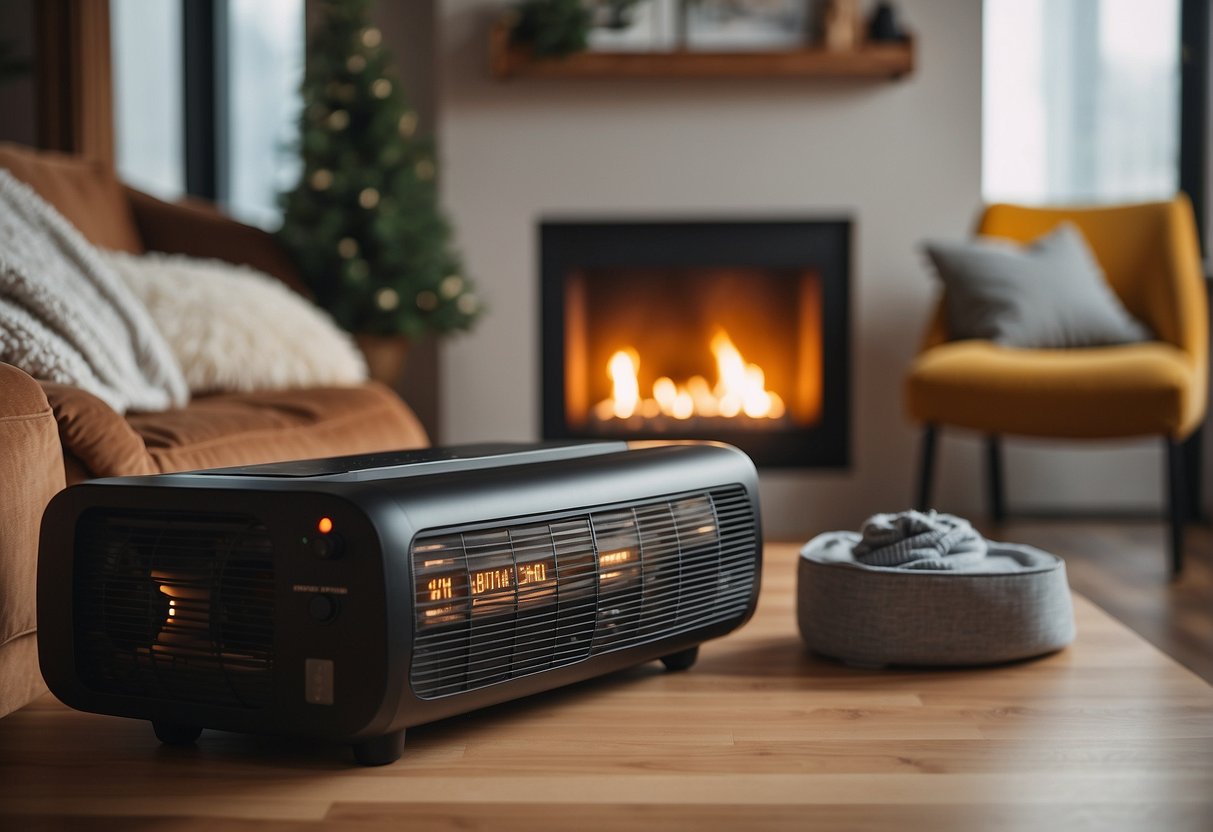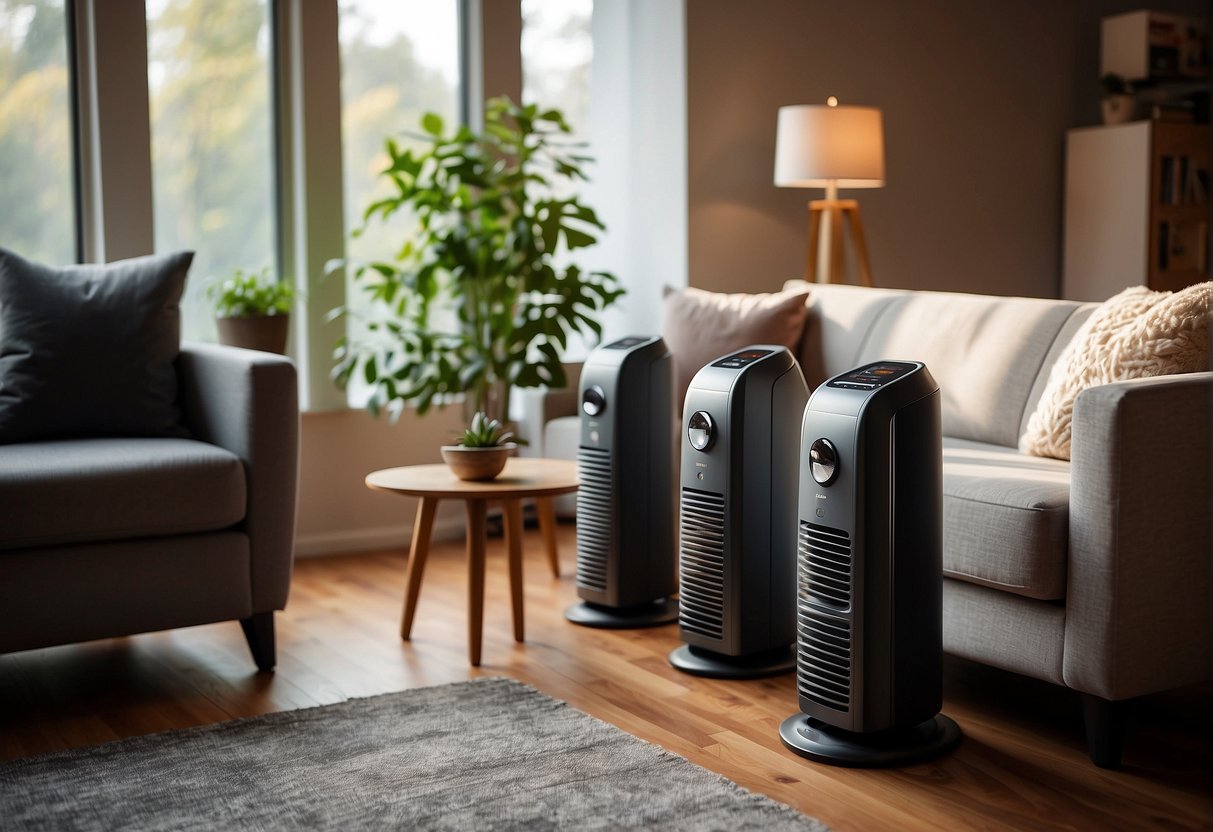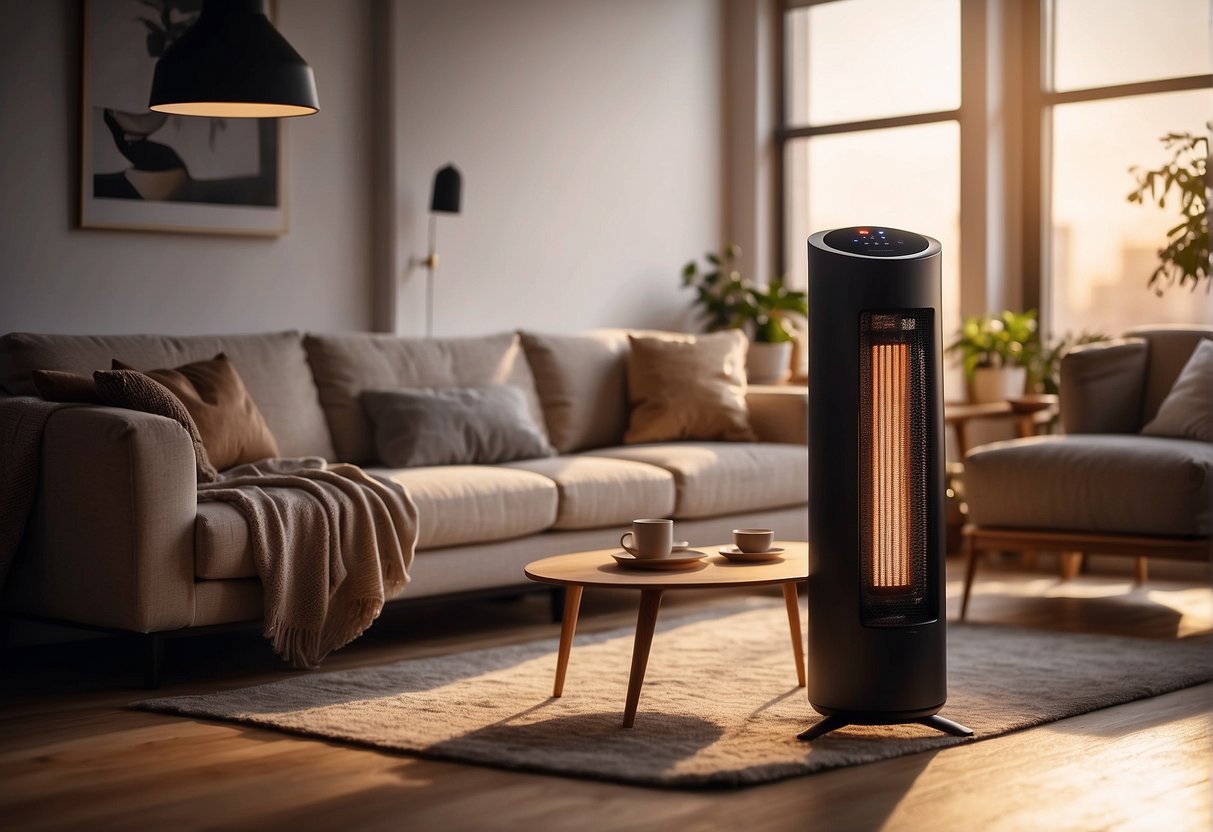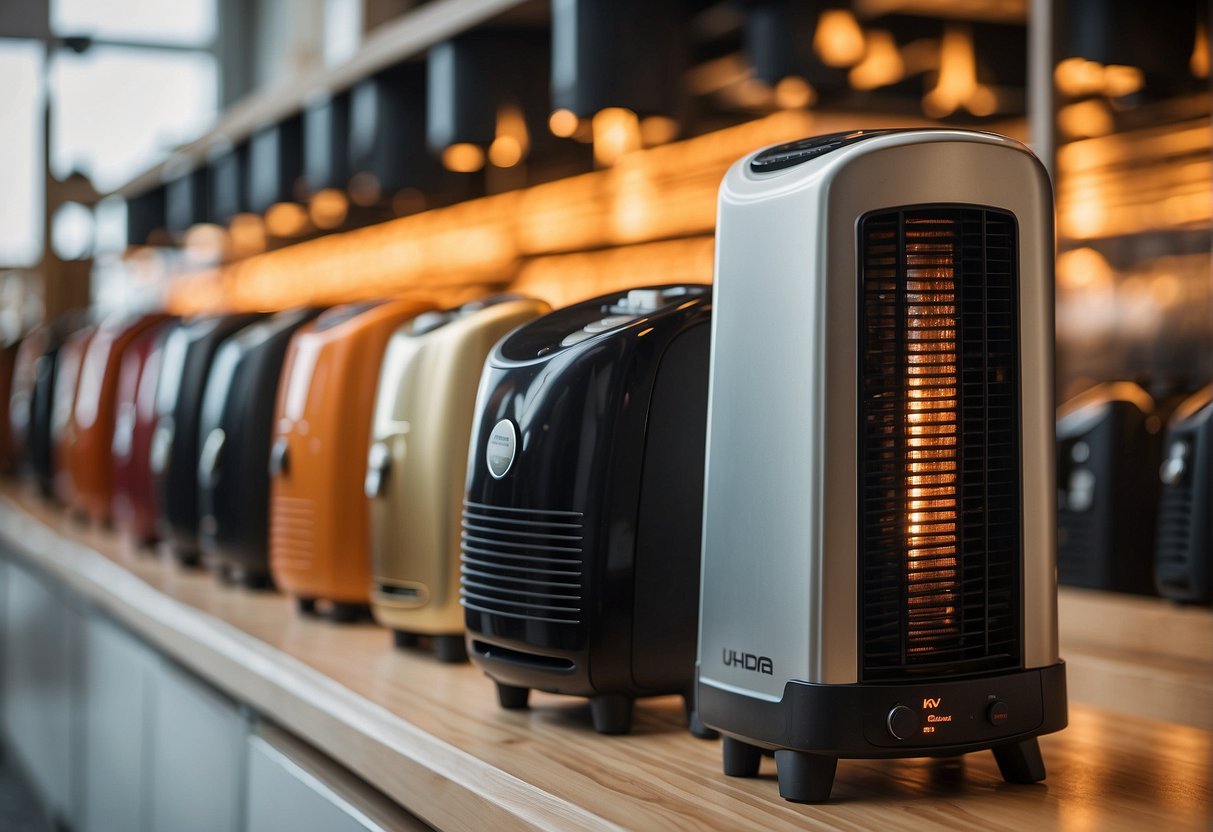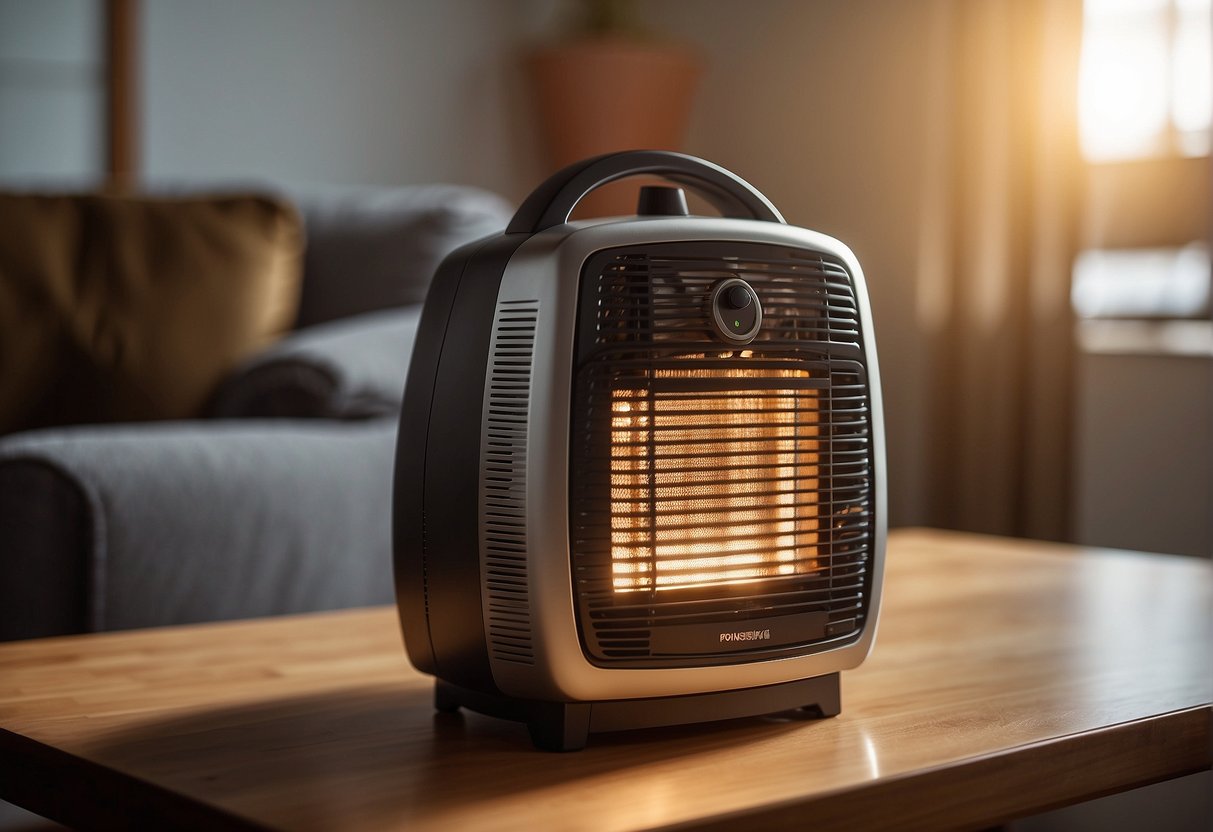When the temperature drops, staying warm and cozy becomes a priority. A space heater can be a convenient and cost-effective solution to add a little extra warmth to a room. With a plethora of options on the market, choosing the best space heater for your needs may seem like a daunting task. This guide aims to simplify the selection process by addressing the critical factors you should consider before making a purchase.
Understanding the different types of space heaters and how they operate is fundamental to making an informed decision. Each type of heater has its own set of features suited to various situations and preferences. Looking beyond heating power, potential buyers should evaluate the safety features, design, and aesthetics of space heaters to ensure they blend seamlessly with their environment.
Performance plays a crucial role in the selection of a space heater. Factors such as energy efficiency, noise levels, and the ability to adequately warm the intended space are important. Prospective buyers should also consider ease of use, portability, and maintenance requirements. Additionally, warranties and customer support vary between brands and models and can impact the long-term satisfaction with the product. By contemplating these factors, one can balance performance and budget to find the most suitable space heater for their individual needs.
Key Takeaways
- Identifying the right space heater involves evaluating types, features, and safety measures.
- Aesthetic and design considerations are important for a heater to complement your space.
- Performance, room size compatibility, and maintenance are key to long-term satisfaction.
Understanding Space Heaters
When selecting a space heater, it is important to consider the type of heater, its design, and how it operates. A well-chosen heater should warm a space quickly and be energy-efficient.
Types of Space Heaters
Space heaters are typically categorized into three main types:
- Convection Heaters: These heaters warm the air in a room. They’re ideal for heating an entire space uniformly and are often designed with energy efficiency in mind.
- Radiant Heaters: Radiant heaters provide immediate warmth, targeting objects and people rather than the air. They’re suitable for spot heating and tend to heat up quickly.
- Combination Heaters: These heaters offer the benefits of both convection and radiant heating. They are versatile and can provide both quick warmth and sustained heat.
How Space Heaters Operate
Space heaters operate on different principles:
- Electric Space Heaters: They convert electrical energy into heat. Most portable space heaters fall into this category and include features like adjustable thermostats and timers.
- Fuel-Based Space Heaters: These heaters use propane, natural gas, or kerosene. They’re less common for indoor use due to ventilation requirements, but they can be very effective in outdoor or well-ventilated settings.
The design of a space heater can significantly influence its operation and energy efficiency. Portable designs allow users to move the heater as needed, while stationary models are intended to heat a specific space continuously. Features like adjustable thermostats, programmable timers, and energy-saving modes contribute to a heater’s overall functionality and efficiency.
Key Features to Consider
When selecting the best space heater, paying attention to key features can greatly enhance comfort, efficiency, and safety. Buyers should evaluate the heater’s capabilities to regulate temperature, ensure secure operation, provide flexible heating options, and offer convenient extra features.
Thermostat Settings
Space heaters with an adjustable thermostat allow users to set a precise temperature for their comfort. This feature helps in maintaining consistent warmth and can also be energy efficient, as the heater modulates its output to maintain the set temperature, reducing unnecessary energy use.
Safety Features
Safety is paramount when choosing a space heater. Look for models with overheat protection, which automatically shuts off the heater before it becomes too hot. Tip-over switches, which turn the heater off if it falls over, are essential, especially in households with pets or children. Some heaters also feature a cool-to-the-touch exterior, which minimizes burn risk upon contact.
Adjustable Heat Settings
The availability of adjustable heat settings—such as low, medium, and high—provides flexibility in heating intensity and energy consumption. A user might prefer a lower setting while they’re sleeping and a higher one when they’re actively using the space. This feature also aids in tailoring the heat output to the size of the room.
Additional Functionalities
Additional features can enhance the user experience. Oscillation improves heat distribution across the room, while a remote control allows for convenient adjustments from a distance. Some space heaters also offer timers for scheduled heating periods, which can contribute to both comfort and energy savings.
Evaluating Space Heater Safety
When purchasing a space heater, safety should be a paramount consideration. Key safety features such as overheat protection and adherence to established certifications can significantly reduce the risk of fire and injury.
Overheat Protection
Most modern space heaters come with an overheat protection feature. This is a built-in safety mechanism that automatically shuts off the heater if it reaches a temperature that could cause overheating. When evaluating space heaters, consumers should:
- Check for Overheat Protection: Ensure that the product specifications explicitly state the inclusion of this feature.
- Understand Functionality: Some models may have a thermal cutoff or a temperature-based automatic shut-off.
Certifications and Standards
To ensure that a space heater is safe for use, it should comply with nationally recognized safety standards and hold relevant certifications. When examining space heaters for safety certifications, consumers should:
- Identify Certifications: Look for labels from organizations such as Underwriters Laboratories (UL) or ETL (Intertek) which indicate that the heater has met specific safety standards.
- Confirm Current Standards: Products should meet or exceed the current safety standards set by recognized safety organizations.
Design and Aesthetics
Choosing the best space heater involves considering design elements that affect usability and integration into your living space. Factors such as heater size and weight, as well as style and appearance, play significant roles.
Heater Size and Weight
Size and weight determine a space heater’s portability and the amount of space it occupies. A lighter heater is typically easy to move from room to room, commonly weighing between 2 to 10 pounds. In contrast, heavier models, which can weigh over 20 pounds, often provide more heating power but are harder to reposition. Key size dimensions to consider:
- Compact size (e.g., 7 x 12.5 x 15 inches): Ideal for small to medium spaces.
- Larger size (e.g., 10 x 24 x 30 inches): Better for large spaces but requires more storage room.
Style and Appearance
The style and appearance should complement your home decor and personal preferences. Space heaters come in a variety of designs, ranging from traditional to modern. Material finishes include plastic, metal, and ceramic, with color options from neutral to bold. Common styles include:
- Tower: Sleek vertical design suitable for contemporary interiors.
- Box or Panel: Classic, unobtrusive look that blends into different settings.
- Retro: Vintage-inspired designs that become a decorative element.
A well-chosen space heater not only provides warmth but also enhances the room’s overall aesthetics.
Performance Factors
When evaluating space heaters, two major aspects that determine their aptitude are heating capacity and efficiency, which directly affect performance and operational costs.
Heating Capacity
The heating capacity of a space heater is measured in watts, indicating its power to heat a specific area. A standard rule is that a heater uses 10 watts to warm one square foot of space. Therefore, a 1,500-watt heater is typically adequate for a 150-square-foot room. It’s imperative to choose a space heater with enough power to cover the intended area for top performance without underheating or overloading the electrical circuit.
Efficiency and Cost of Operation
Efficiency is pivotal in mitigating the cost of operating a space heater. Higher efficiency heaters convert a greater amount of electricity into heat, doing so more swiftly and with less energy waste. This translates into faster warm-up times and lower electricity bills.
- Convection heaters typically offer more efficient room heating for prolonged periods.
- Radiant heaters work faster but may cost more to operate if used for extended times.
It is also beneficial to look for models with energy-saving features such as adjustable thermostats, programmable timers, and low wattage settings, which assist in optimizing efficiency and reducing costs.
Space Heater Brands and Models
When selecting a space heater, it’s essential to assess the reputation of brands and specific features of models to find a unit that best suits one’s needs.
Top Brands Overview
Lasko: A trusted name in space heating, Lasko offers a variety of models known for their durable construction and efficient heating capabilities. Their ceramic heaters are especially popular for personal and home use.
DeLonghi: DeLonghi’s space heaters often include oil-filled radiators, which are celebrated for their long-lasting heat and energy efficiency. Many models come with user-friendly features like digital controls and programmable timers.
Honeywell: Renowned for their wide range of heating solutions, Honeywell heaters provide reliable performance. They offer easy-to-use portable heaters with features such as overheat protection and cool-touch housing.
Dyson: Dyson stands out with their sleek design and multipurpose capabilities. Their bladeless models serve as both heaters and fans, incorporating air purification technologies for added value.
Heat Storm: Heat Storm specialises in infrared heaters that are touted for their ability to heat up spaces quickly while maintaining a compact and portable design.
Vornado: Vornado’s approach to space heating includes vortex air circulation, ensuring that heat is evenly distributed throughout the room which makes them highly efficient in maintaining room temperature.
Model Comparisons
When comparing models, it is crucial to consider several aspects.
- Heating Capacity: Evaluate the room size each model can comfortably heat.
- Lasko models like the 754200 Ceramic Heater are suitable for small to medium rooms, employing widespread oscillation.
- Heat Storm’s HS-1500-PHX-WIFI Infrared Heater has Wi-Fi connectivity and is designed for larger spaces.
- Safety Features: Look for overheat protection, cool-touch exteriors, and tip-over shut-off functions.
- Honeywell heaters, such as the HCE200W UberHeat Ceramic Heater, typically include multiple safety features.
- DeLonghi’s oil-filled radiators come equipped with safety shut-off to prevent overheating.
- Energy Efficiency: Notice which models provide high heat output while conserving energy.
- Dyson heaters feature precise temperature control to help reduce power consumption.
- Vornado’s energy-smart heaters use variable speed settings to adjust heat output and power usage.
Be aware that various models within each brand might suit different needs better, and comparing individual model features is as important as the brand’s overall reputation.
Comfort and Noise Levels
When selecting a space heater, comfort and noise levels are critical factors to consider. A quiet space heater enhances a user’s comfort, particularly in environments where silence is golden, such as in an office or bedroom setting.
Quiet Operation Heaters
Space heaters that prioritize low-noise operation use technologies like ceramic heating elements or oil-filled radiators to minimize sound. They generate warmth without a fan, which drastically reduces noise output. Here’s what buyers should look for:
- Decibel Rating: Heaters with a low decibel rating (dB) are preferable for a tranquil environment.
- Fanless Design: Often, fanless heaters are quieter. Models using natural convection or radiant heating tend to be silent.
Buyers should note the following key specifications to ensure their comfort isn’t compromised by noise:
| Feature | Description |
|---|---|
| Adjustable Settings | The ability to adjust output and temperature can reduce operational noise. |
| High-Quality Components | Models constructed with superior parts typically operate more quietly. |
Those with particularly acute sensitivity to noise might consider:
- Placement: Positioning the heater at a distance from sitting or sleeping areas can alleviate the impact of any residual noise.
- Noise-Canceling Features: Some heaters include specific elements designed to mute sound, further enhancing the user’s comfort.
In summary, a heater’s noise level can profoundly affect one’s comfort, and hence, should be an integral part of the decision-making process.
Portability and Room Size
When selecting a space heater, considering the unit’s portability and the size of the room it is intended to heat is essential for efficiency and convenience.
Moving and Storage
Portability is a crucial aspect of space heaters, as these small appliances often need to be moved from one location to another. A lighter model with a carrying handle or casters can be valuable for users who plan to transfer the heater between rooms. Additionally, models designed with a compact shape and a retractable cord facilitate easier storage when the heater is not in use.
Matching Heater to Room Size
The effectiveness of a space heater is greatly influenced by matching the heating capacity to the size of the room. An average-sized room, typically up to 150 square feet, can be adequately heated by most small to medium-sized heaters. Here is a simple guideline:
- Small room (<100 sq ft): A space heater with 750 watts of power.
- Medium room (100-150 sq ft): A heater with 1,500 watts of power.
- Large room (>150 sq ft): Consider multiple heaters or a larger unit with higher output, potentially over 1,500 watts.
Remember, insulation and room layout can also impact how well a space heater performs in a given space.
Maintenance and Warranty
Proper maintenance ensures that a space heater operates efficiently and safely, while warranty coverage can provide peace of mind. Understanding the specifics of these aspects can help consumers protect their investment.
Cleaning and Care
It is essential for consumers to regularly check and clean their space heaters to maintain optimal performance. They should follow the manufacturer’s instructions for specific cleaning guidance. Generally, the steps include:
- Unplugging the heater: Safety first. Always disconnect the heater from the power source before starting any maintenance.
- Dusting regularly: Use a soft, dry cloth to wipe the exterior of the heater to prevent dust accumulation.
- Cleaning the intake and exhaust vents: Keeping these areas clear of debris can prevent overheating and potential hazards.
- Storing safely when not in use: If the space heater is a seasonal item, it should be stored in a cool, dry place, away from direct sunlight and moisture.
Warranty Information
When purchasing a space heater, consumers should thoroughly review the warranty provided by the manufacturer. The warranty typically includes:
- Duration: Most space heaters come with a one-year warranty, but this can vary.
- Coverage: Warranty often covers defects in materials and workmanship. It’s critical to understand what is and isn’t covered.
- Claims process: In case of a defect, consumers usually need to contact customer service. Keeping the purchase receipt and adhering to the manufacturer’s claim process is crucial for a smooth warranty experience.
| Warranty Aspect | Details to Consider |
|---|---|
| Length of Warranty | Commonly 1 year, can extend with registration. |
| Coverage | Check for parts and labor inclusion. |
| Limitations | Be aware of actions that could void warranty. |
| Registration | Some companies require product registration. |
Consumers should also be aware that certain maintenance actions or using the space heater in a manner inconsistent with the manufacturer’s instructions can void the warranty. Always consult the warranty documentation for specific information regarding maintenance requirements and coverage limits.
Pricing and Budget Considerations
When considering the purchase of a space heater, budget is a crucial factor. Space heaters can range from affordable basic models to high-end units with advanced features.
Affordable Options: For those with a strict budget, there are economical space heaters that provide essential heating capabilities without the additional frills. Amazon Basics, for example, offers a selection of cost-effective heaters that often receive positive ratings from buyers seeking value for money.
Mid-Range Heaters: For buyers looking for a balance between price and features, the mid-range market offers space heaters with additional settings such as programmable timers and remote controls. These extra features can contribute to a more convenient and efficient operation, often reflected in their moderate price increase.
High-End Models: At the top of the price spectrum, space heaters with premium features, such as smart-home integration and energy-efficient technology, command higher prices. These models appeal to those prioritizing advanced functionality and aesthetics.
It’s important to align expectations with budget. While it’s possible to find space heaters under $30, they may not have the durability or effectiveness of models in higher price brackets. Conversely, the most expensive options may offer features that go beyond the necessities of basic heating.
| Price Range | Features |
|---|---|
| $20 – $40 | Basic heating, simple controls |
| $50 – $100 | Added features like timers |
| $100+ | High efficiency, smart features |
Buyers should assess both current prices and potential energy consumption to estimate the space heater’s overall cost. Considering running costs alongside the initial investment will provide a clearer picture of the space heater’s value over time. It’s also wise to check for any special deals or discounts that could make higher-priced models more accessible.
Frequently Asked Questions
When choosing the best space heater, it’s important to consider energy efficiency, size requirements, safety features, and heater type. Understanding these elements ensures you select a heater that fits your specific needs and promotes a safe, comfortable environment.
What factors should be considered when selecting an energy-efficient space heater?
To select an energy-efficient space heater, look at models with programmable thermostats and energy-saving modes. Checking for energy certifications, such as Energy Star, can also guide you to heaters with better overall efficiency.
How can I determine the correct size and power requirements for a space heater in my room?
The size and power requirements depend on the room’s square footage. Generally, a space heater requires 10 watts of power per square foot of space. Measure the room and match the heater’s wattage accordingly to ensure adequate heating.
What are the safety features to look for in a high-quality space heater?
A high-quality space heater should have safety features that include automatic shut-off if tipped over, overheat protection, and a cool-to-touch exterior. Additionally, it is beneficial if the heater has a timer or thermostat to control the heating cycle.
What is the difference between ceramic, infrared, and electric space heaters, and which is optimal for home use?
Ceramic heaters are good for quickly heating small spaces; they use a ceramic plate to absorb and release heat. Infrared heaters emit rays that warm directly, making them efficient for targeted heating. Electric heaters are versatile and can heat a room evenly. Choose according to whether you need spot heating or whole-room warmth.
Which space heaters are known for being particularly economical for prolonged use?
For economical prolonged use, consider an infrared heater or an oil-filled radiator. These types of heaters maintain warmth without consuming high amounts of electricity, making them cost-effective for continuous operation. Evaluating heaters by their energy consumption per hour can provide insight into long-term savings.
When choosing a space heater for a bedroom, what aspects should be taken into account to ensure comfort and safety?
For a bedroom, quiet operation is key for comfort, as well as adjustable temperature settings. Safety aspects such as a programmable timer, automatic shut-off, and non-combustible materials are crucial for peace of mind while sleeping.
By focusing on these aspects when selecting a space heater, you can enjoy a warm, safe, and energy-efficient heating solution tailored to your home’s needs. To further aid your understanding and decision-making, consider consulting expert reviews and resources available, such as those provided by Savvy Home Guide.
List of Recommended Space Heaters
All of our Recommended models scored at least Very Good for temperature control, safety, noise, and easy of use–something none of the spot-heating radiant models managed. All models have overheat protection; our top picks add a tip-over switch and were easy to control and carry. Most also cost under $100, not $300 or more.
CR Best Buys offer the best combination of performance and value; all are Recommended. Recommended models are high-scoring models that stand out for the reasons below.
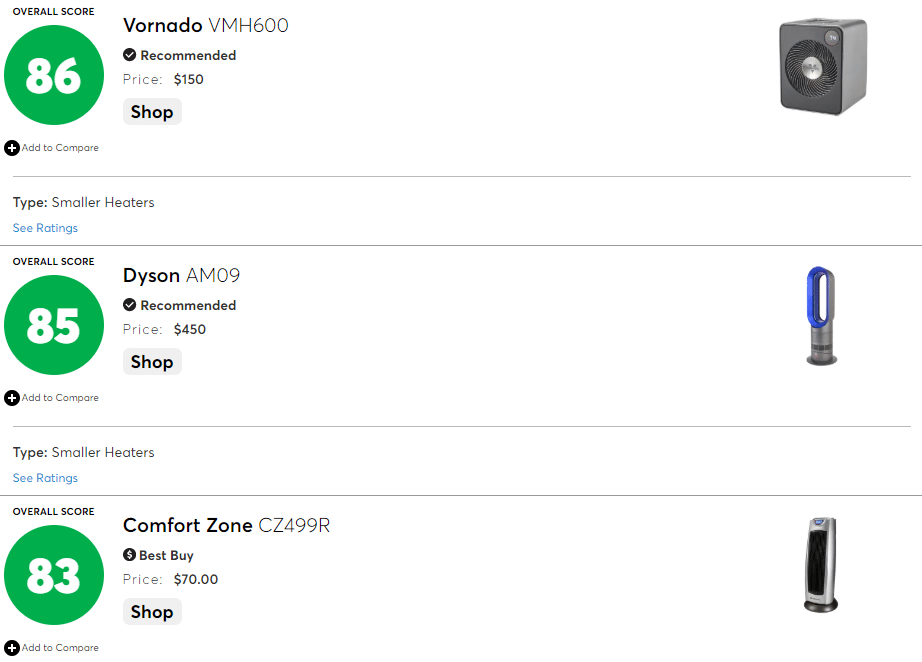
Source: https://www.consumerreports.org/products/space-heater/recommendations/
Space Heater Safety Tips
Practicing these general safety tips will allow you to safely enjoy the warmth and other benefits of a compact, efficient and effective portable space heater.

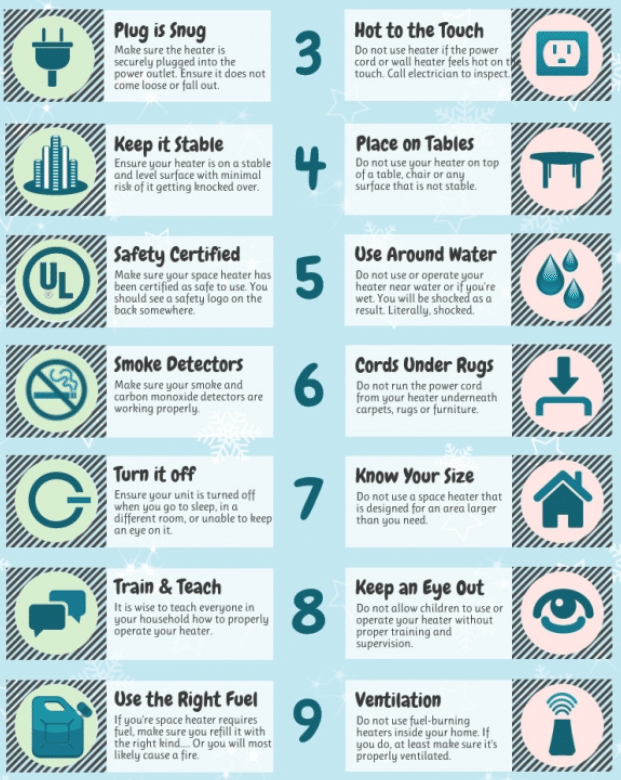
See the whole image here.

